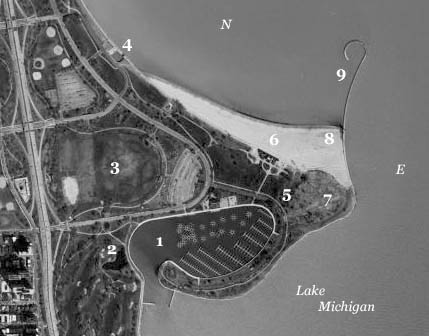Northerly Island, or what used to be Meigs Field, is one of the more recent bird attractions in Chicago. The ex-airport has now been transformed into grassland that is ripe for holding migrants. One should note that when visiting, parking costs a few dollars, but is usually worth it as the birding is usually fantastic.
Nelson’s and LeConte’s Sparrows can be found here with a bit of work, but seem to be a little more common and easy to find than at Montrose. In the winter, Northerly is transformed into a fantastic location for resident winter birds, such as Northern Shrikes, which will sometimes winter on the island. Northerly sits on the lake as well, which means ducks and other water birds can easily be found. Three sides of the “island” are covered in water, so duck numbers are usually high when there is open water. This past winter, Thayer’s, Glaucous, and Iceland Gulls all were found in the harbor, along with a long staying Long-tailed Duck. All three Scoters can also be found here usually near the harbor mouth on the south-west side.
There also usually is a large number of wintering raptors on the island, with a few Rough-legged Hawks in good years, Red-tailed Hawks, and breeding American Kestrels. In migration, Short-eared Owls can be found along with Northern Harriers. Passerine migration is also good here, with good numbers of grassland species. Henslow’s Sparrows can be found, as well as Sedge and Marsh Wrens.
As with Montrose Point, Northerly is a small magnet for rare and uncommon birds. In past years, Sage Thrasher, Brewer’s Sparrow, and Harlequin Duck have been found. Recently, Sam Burckhardt found a Red-throated Loon, a hard bird to see close to shore, across from Northerly Island near the Shedd Aquarium. The bird stayed for at least 2-3 more weeks, and was later found swimming in the harbor. Northerly is a fantastic mix of habitats, as there is a mix of both grasslands and open water.
Also, if visiting Northerly Island, one should consider visiting the Field Museum, Shedd Aquarium, and the Adler Planetarium. They are great attractions, and are great destinations for tourists.
